
ESS (Term 1 Semester 1)
Objective:
Understand and Recognize your EVS.
Greenhouse gases is causing global warming.
Whats environmental value system?
Its a “World view” or set of paradigms that shape the ways that individuals and groups approach environmental issues.
How assumptions, values, and beliefs, and worldwide views can
Ecocentrism (Nature and ecology Centered) → Bio-rights
Nature: Environmental conservation is central to decision making.
Society: Humans are part of nature.
Individual responsibility and accountability.
All life has inheret value.
We should not cause extinction of other species.
We should protect habitats and ecosystems.
Humans are not more important than other species.
Resources are limited so we have to be careful.
We need the earth more, than it needs us.
Chief seatlle, Aldo Leapold (1949)→A Sand County Almanac, Mahatma Gandhi is ecocentric.
Self restraints in human behavior, and less materialism.
What should we do about climate change?
Travel by bike
Dont travel by plane
Turn light off
Close down factories → economic development isnt as important as protecting organisms.
Anthropocentrism (people (humanity) centered)
Nature: The environment is a resource for humans to use as needed.
Society: Human health and well-being are central in decision-making.
People as environmental managers of the environment.
Governmental regulation, taxes, legislation, and regulation.
Population control given equal weight to resource use.
Humans are the most important species.
People living in MEDC’s (more economically developed countries)
are more likely to hold this view. WHY?
Rchel Carson, is Anthropocentrism and Ecocentrism. George W Bush, Barrack Obama is Anthro.
Humans can “manage” the issues.
Protect “useful” species.
What should we do about climate change?
Raise taxes/petrol/fuels.
Create laws on “clean” fuel and energy.
Carbon Taxes
Take action so that it doesnt harm us in the future
Technocentrism
Nature: Nature is a model, but can be replaced by technology when needed.
Society: Human health and well-being are central to decision-making.
Technology can keep pace with and provide solutions to environmental problems.
We must understand natural processes in order to manage and control these resources.
We can solve any problem we cause. (That means I can employ technology to resolve it)
Economic growth is a good thing.
Solve problems while increasing living standards.
Economic growth improves technology = care for the earth as we need to.
What should we do about global climate change
Solar/ wind power
Improve efficiency of cards
Adjust to new global climate
Use technology
EVS Spectrum
Deep Ecologists (Extreme Ecocentric)
Nature > humanity
Humans are not any more important than any other living thing.
All natural resources are for human use. Humans should consume less.
Seek a more holistic view of the world we live in.
We MUST completyely change our behavior, by prioritizing living things and the planet.
Self reliance (Soft ecologist) → prefer small scale (start small, start from your own environment)
Small-scale, local community action.
Individuals make a difference. each individuals should start making small actions, the world would change.
Self-sufficiency in resource management.
Ecological understand a principle for all aspect of living.
Environmental Managers (More anthropocentric) →environment can be used if managed properly.
Earth needs tending
Governments legislate and protect the environment
No radical political agenda but promote working to create change within the existing social and political structures.
Current economic growth can be sustained if environmental issues are managed by legal means or political agreement.
Conucopians (Extreme Ecocentric)
Earth is unlimited. We can do anything, and there might be consequences but we are able to deal with it.
There is no correct environmental value systems.
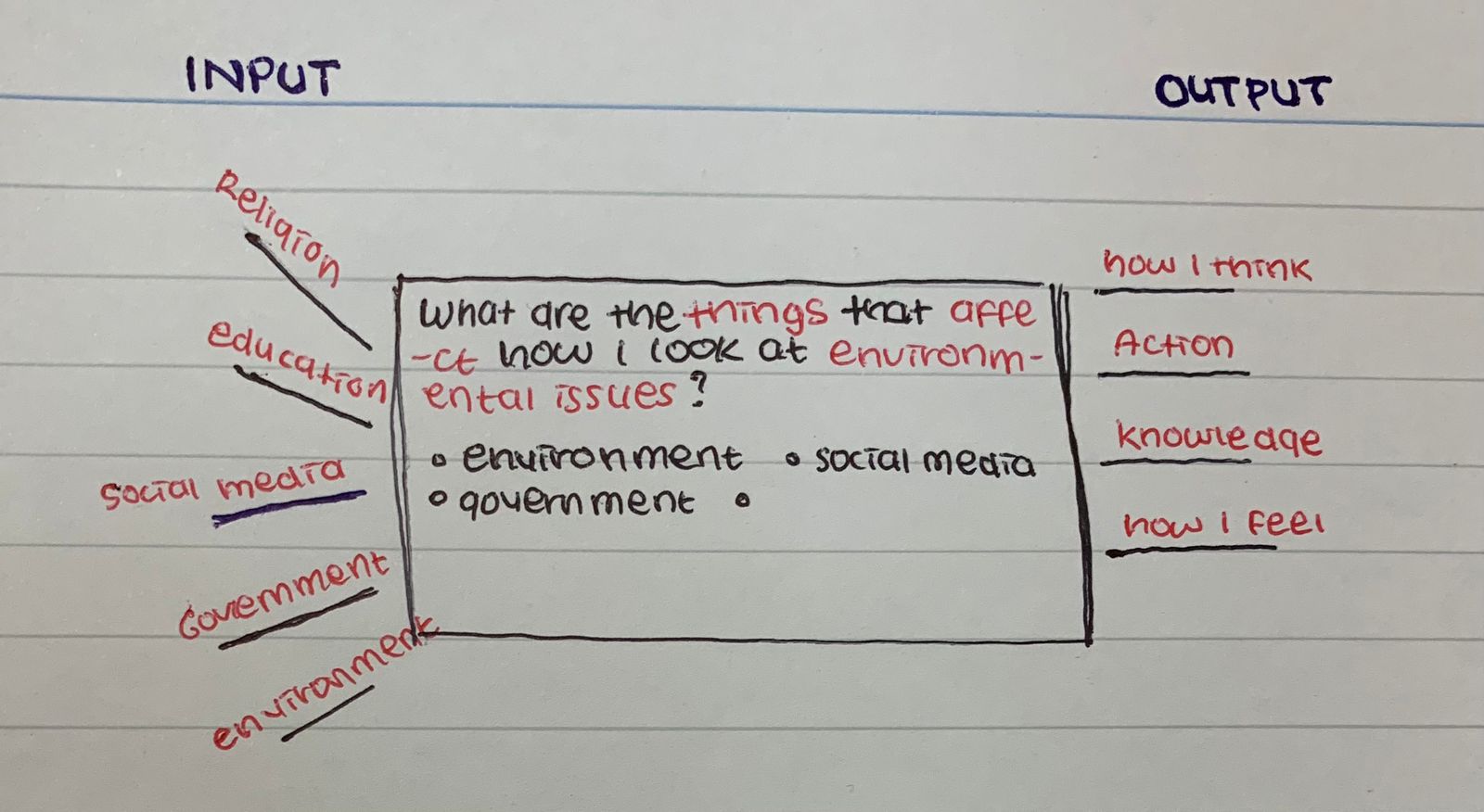
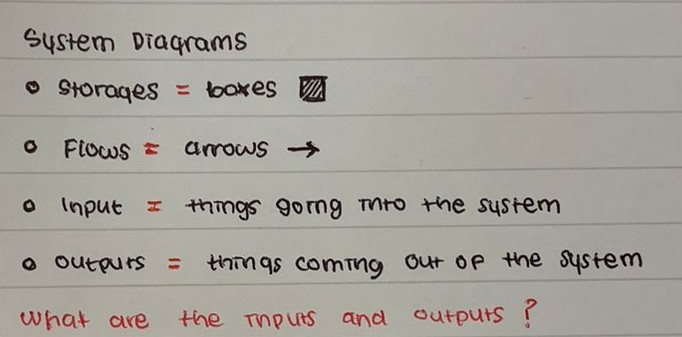
Open → Matter/ energy is able to go in and out.
Examples: (1) Tree - They take in solar energy and carbon dioxide, (2) Turbine - where the system boundary is the turbine housing. The turbine sucks in air through the boundary, which results in a mass flow. The air is then compressed and mixed with fuel and heated (combustion of fuel), which then lead s to a strong expansion of the gas.
Close → Matter cannot go in or out. Energy can.
Examples: (1) Air conditioner, (2) Electric hair straightner.
Isolated → does not have a net external force and does not exchange matter or energy with its surroundings.
No totally isolated examples. Most examples have minimum absorption of energy.
Intrinsic Value → A characteristic of a natural system that has an inherent worth, irrespective of economic considerations.
Include values based on - culture, aesthetics, and bequest significance (value to children and grandchildren).
It does not have an economic worth, but intrinsic worth → Valuable bc of its cultural value. It has worth it because it has something unique or interesting.
Different EVS ascribe different intrinsic values to components of the biosphere:
Ecological values = no market price.
Ecosystems valued on intrinsic grounds may not provide identifiable goods or services and thus may remain underpriced or undervalued from an economic view.
Green politic → group of people getting together to solve issues and press through politics and discussion (theyre always ecocentric→ theyre looking for sustainable and ecologically society)
Ex. Green party in New Zealend, Green campaigners in UK, and many more.
Example in Indonesia Indonesian Justice and Unity Party (Partai Keadilan dan Persatuan Indonesia)
Ideology →
How important is it in rainforest conservation?
Examples of issues where green politics influenced the EVS of people in Indonesia
Energy changes, and never destroyed.
Example of energy flow is food chain.
1st law of thermo dynamics is the principle of conservative energy, which states that energy in an isolated system can be transformed but cannot be created or destroyed.
1st and 2nd Law of Thermodynamics
1st Law of Thermo dynamics
Amount of energy within a system is constant. The form of energy changes.
Implications of 1st law of Thermodynamics → Energy cannot be creater or destroyed.
If its an open system (ecosystem), once energy entered it cannot increase. Energy has to keep entering to keep the flow.
Food chain, energy transforms from light → chemical → heat energy. This Increases entropy (measure of disorderlyness), so theres less available energy to do work, therefore at higher thropic levels there are fewer animals. 10% transfer, the rest loss.
Universe loves disorderlyness → the more better it is.
We have small food chain because → energy loss (as heat/ feces).
Animals at higher trophic levels must eat a large number of smaller animals, so if there are non-biodegradable toxins in smaller animals, so if there are non-biodegradable in the chain they will become more progressively concentrated. → Basically they will be affected more.
Vegans → GET MORE ENERGY BC THEY ONLY EAT PLANTS MOO.
Energy can only be converted from one form to another.
Potential energy → what you store in your body. Energy stored → fat. Fat will convert to energy. When you need it, its instant energy.
90%/1800 kj of energy will be used by living species in daily actions. 10%/200kj energy is stored.
2000kj is something that is consumed by that living species, in this context is a cow.
2nd law → Energy is always lost in a system to a less useful form.
Entropy is the amount of disorder in a system.
Entropy increases as energy is used.
Entropy→ favors chaos. The more the chaos is, the more it is favored.
Entropy increases when we move.
The major difference of animal cells, and plant cells.
Plant cells → It has an additional wall around it (its made of - cellulose → Long chain of carbon).
Forest fire: Cellulose + Oxygen (High potential energy) → Carbon monoxide (H2o), Carbon dioxide (CO2), heat, light, sound, & carbon. (Low potential energy)→ It becomes unorganized.
That was an example of increase entropy → meaning that there is more chaos.
Potential energy decrease < while entropy increases.
Animal cells →
Entropy always increases (less energy for work)
Less energy at each level ecological pyramids
Transformations are not efficient
Living systems require constant input of new energy from the sun
Wolf 4200 kg/km2
Red Fox 2100 kg/km2
Snowshoe hare 20,925 kg/km2
Grass 2.0925 x 10’7 kg/km2

Available energy decrease with time as order takes energy.
Energy transfer is not 100% effective.
There is less and less available energy in each successive level.
10% available.
The second law explains the inefficiency and decrease in available energy along a food chain and energy generation.
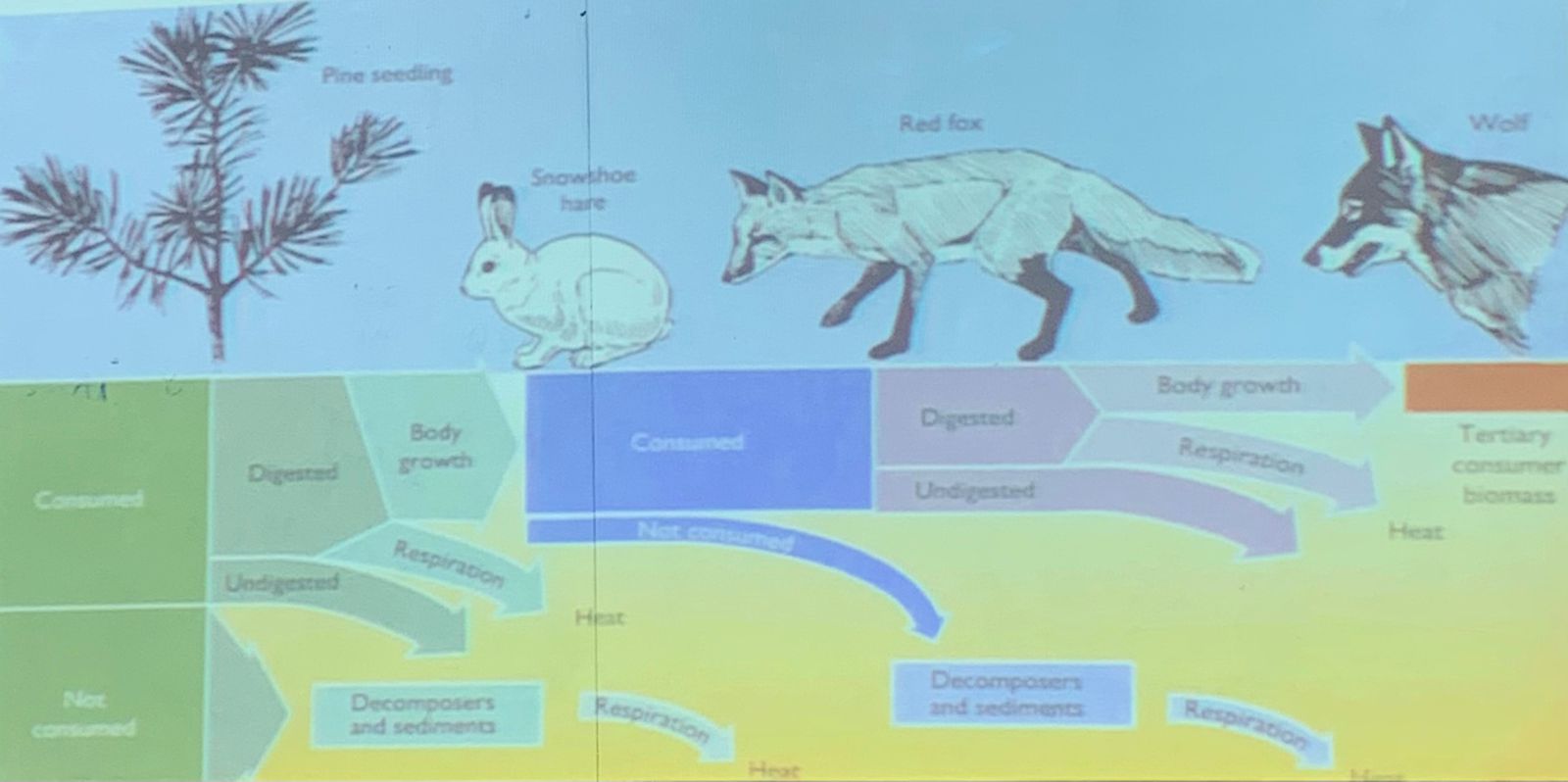
Efficiency → how much work i can do with the amount energy I have.
Its a comparison of the amount of work or energy done to the amount of energy that it consumed
Efficiency = useful outputs/inputs x 100
Ex. more efficient to eat plants bc theres less energy loss.
As an open system, an eco system will normally exist im a stable equilibrium, either in a steady-state of equilibrium or in one developing overtime (ex. successions), and maintained by stabilizing negative feedback loops.
Steady-state equilibrium
Maintains a stable system due to constant flow of inputs and outputs.
Ecological system requires inputs and outputs in order to function.
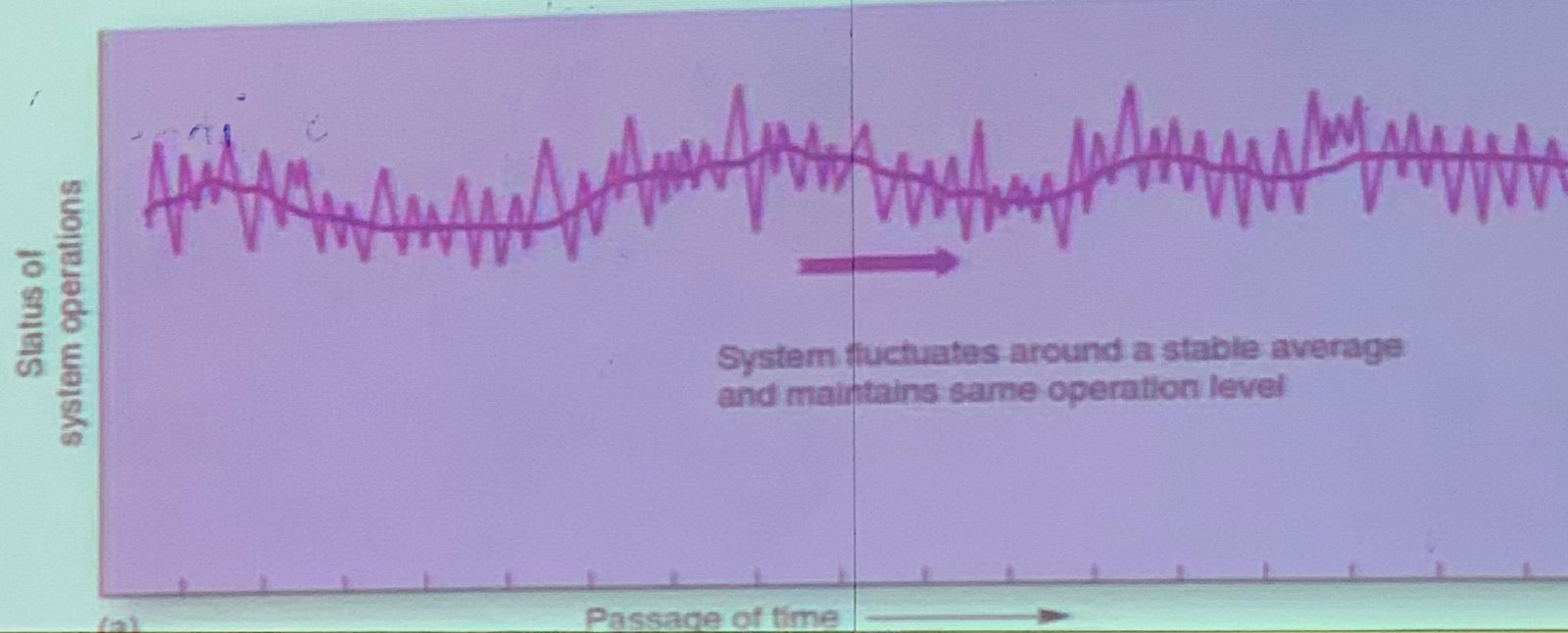
City with population is considered to be open system because energy can be absorbed by humans (through sunlight, or heat body of other people, and many more), and it will be transferred through different forms such as sweat, body heat, movements, and many more.
Static equilibirum
Doesnt apply to natural systems, because no inputs/ outputs so no change occurs.
Always balance
Inanimate objects
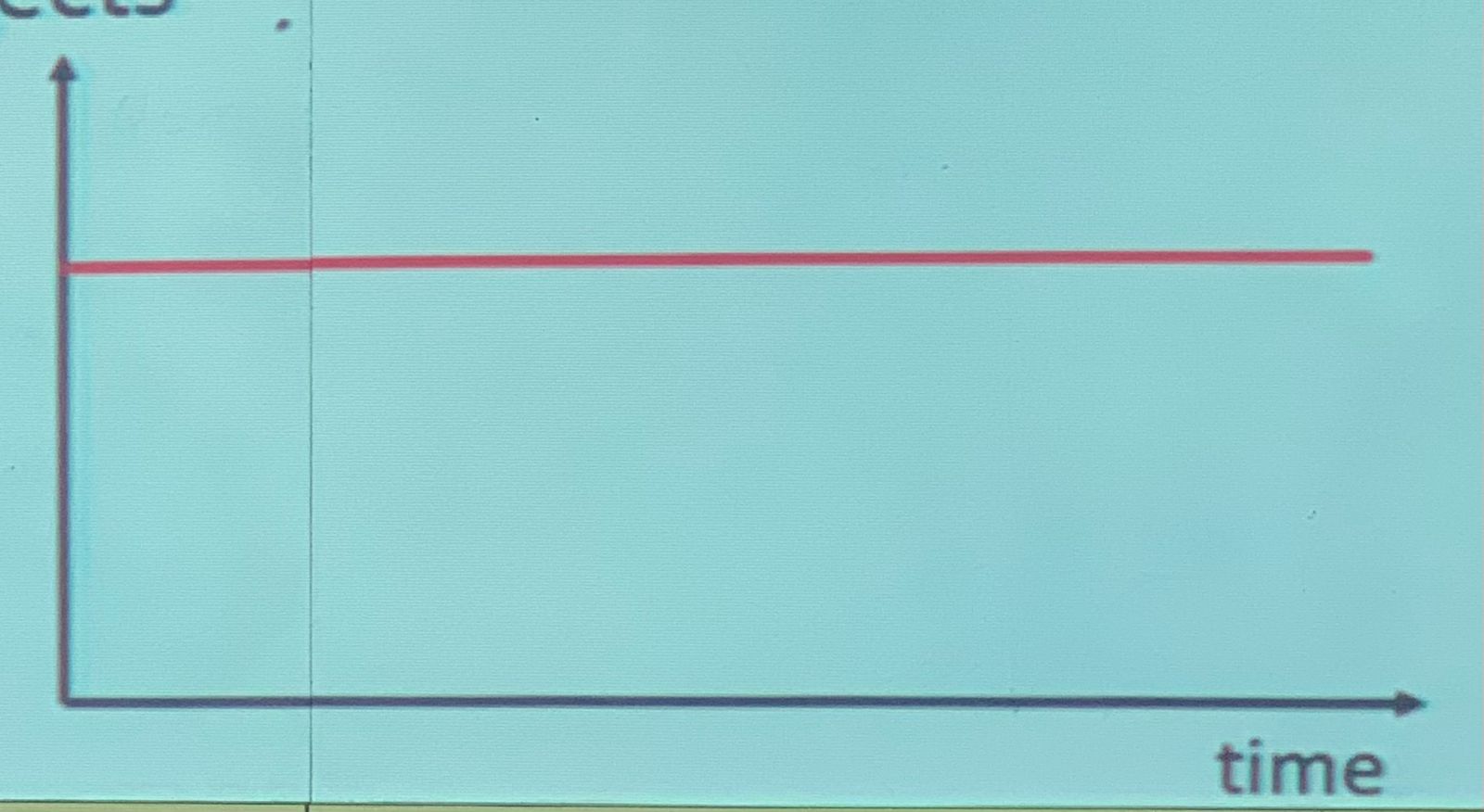
Stable
Returns to balance after disturbance (ex. rubber)
Unstable
Achieves new balance after disturbance (ex. car crash → car doesn’t turn to normal)
A system that is an unstable equilibriuk and faces a disturbance will not return to the original equilibrium and establish a new one.
As long as there is sunlight, plants can perform photosynthesis. Night time → plants adopt new equilibrium ro produce food also known as respiration.
Ecosystems said to be “Self-regulating”
Each contain feedback mechanisms which function to maintain the system in its equilibrium state.
Positive
Negative
Mutual casual interaction → x affects y, y affects x.
Positive feedback → Amplifies a particular state from previous conditions. Not necessarily good.
e.g. → Blood Clotting. The Menstrual Cycle. Labor and Childbirth. Digestion. Nerve Signaling.
Negative feedback → Wave-like equilibrium because it curtail the state for a period of time the state for a period of time.
e.g. → desert weak, rainforest strong, temperature regulation. Blood pressure regulation. Blood sugar regulation.
If an interaction is taken away, the loop breaks.
Negative feedback loops (stabilizing) happen when the output dampens the effects and promotes a return to stability.
e.g. → fox eat rabbit, rabbit population goes down. Fox population goes down, rabbit population increases.
Positive feedback loops amplify change and deviates from stability.
e.g. → temprature → permafrost thaws → greenhouse gases release (and repeat).
Positive feedback stacks.
Resilience of a system
Tendency to avoid tipping points (when balance tips to such a point that it cannot return) and maintain stability/ respond to a disturbance.
absorb disturbance without shifting to a different state and losing function.
More complex, more feedback looks more resilient.
Disturbances
Fires, flooding, insect population explosions, pesticides, windstorms, and fracking, and many more.
Some disturbance can significantly impact an ecosystem that some species cannot recover (threshold).
Size of storages = amount of storages in a system
Climate Emergencies around the world
China heatwaves, Record breaking temp in Europe, Scientists have been wake up call -ing for years.
Objectives:
Outline what is resilience
How resilience can be affected by humans
Activity
Describe sustainability and sustainable development
Humans can affect the resilience of systems by reducing these storages and diversity.
Positive feedback tends to amplify and drive a system toward a tipping point.
The minimum amount of change within a system that will destabilize it → causing it to reach a new equilibrium or stable state.
Small changes within a global system can transform a relatively stable system into a very different state of climate.
Identifying phenomena are capable of passing tipping points can be tricky
Tipping elements → used to describe large-scale components of the earth system which may be subject to tipping points.
Arctic sea ice
Ice sheets
El Nino (Warmer water spreads further and stays closer to the surface).
Amazon rain forest
Places considered to be red zones are →
Apo Island Marine Sanctuary: Negative tip
Tipping point = Intro of destructing fishing methods
More use of destructive methods
Degradation of coral reef habitat and fish stocks
More fishing away from island
less concern for sustainability of marine eco system
What is the tipping point
Bowary → Manhattans lower east.
Eco tipping point → small action that became a catalyst for major change.
Bowery → agricultural district.
Lake known as a collect pond was a favorite fishing spot.
Bowary decline at the end of 1700s. due to pollution accumilating as local manufacturers increased in production and waste. Population also exploded.
1800s elevated railroad → buildings became trash dumps and flop houses.
The lake got polluted aswell
HW: Find a place in Indo that can be counted as sustainable
Parepare, South Sulawesi as the Most Sustainable City in the Field of Energy and Climate Change.
Distinguish between MEA and EIA
EIAs → Incorporate baseline studies before a development project is undertaken.
What's their job? They assess the environmental, social, and economic impacts of the project, predicting and evaluating possible impacts and suggesting mitigation strategies for the project.
Usually followed by an audit and continued monitoring. Each country or region has different guidance on the use of EIAs.
When is it prepared? Before a proposed large-scale project.
What steps do you take?
Baseline Study → Looks at potential changes to biodiversity, climate and amenities as well as potential effect on people in the area and changes to their community structure, livelihood or health.
Forecasts and predictions about the impact of the proposed project, then can make the change accordingly to minimize impact.
MEA → International assessment of the effects of human activity on the environment.
Gives a scientific appraisal of the condition of the world’s ecosystems.
Who are the participants? Reps from UN, NGO, academics, business leaders, reps from indigenous people.
Summarize
What must EIA include?
aBaseline study to record current situation.
A survey: A report to assess the potential impact of the project
A prediction to indicate the importance of the likely impact
A summary to consider how the effects can be limited to reasonable extent.
Bandmarks (from 1-9) → Write these down during planning.
Knowledge
Linkages
Examples
Analysis
Conclusion
Point & Non-point source
Whats point source?
What are the regulations?
Localized
Often single party is responsible
One jurisdiction
Examples
Draining pipe
Leaking tank
Factory chimney
Whats non point?
Pollution that cannot be tracked to origin or source.
What are the regulations
Identify multiple sources
Who is responsible
(continue)
Examples
Agricultural run off
(continue)
POPs (Persistent Organic Pollutants
Cant be broken down by living organisms
Passed along food chains as a result
(continue)
Examples
Heavy metals
Older pesticides
(continue)
Objective:
Understand and Recognize your EVS.
Greenhouse gases is causing global warming.
Whats environmental value system?
Its a “World view” or set of paradigms that shape the ways that individuals and groups approach environmental issues.
How assumptions, values, and beliefs, and worldwide views can
Ecocentrism (Nature and ecology Centered) → Bio-rights
Nature: Environmental conservation is central to decision making.
Society: Humans are part of nature.
Individual responsibility and accountability.
All life has inheret value.
We should not cause extinction of other species.
We should protect habitats and ecosystems.
Humans are not more important than other species.
Resources are limited so we have to be careful.
We need the earth more, than it needs us.
Chief seatlle, Aldo Leapold (1949)→A Sand County Almanac, Mahatma Gandhi is ecocentric.
Self restraints in human behavior, and less materialism.
What should we do about climate change?
Travel by bike
Dont travel by plane
Turn light off
Close down factories → economic development isnt as important as protecting organisms.
Anthropocentrism (people (humanity) centered)
Nature: The environment is a resource for humans to use as needed.
Society: Human health and well-being are central in decision-making.
People as environmental managers of the environment.
Governmental regulation, taxes, legislation, and regulation.
Population control given equal weight to resource use.
Humans are the most important species.
People living in MEDC’s (more economically developed countries)
are more likely to hold this view. WHY?
Rchel Carson, is Anthropocentrism and Ecocentrism. George W Bush, Barrack Obama is Anthro.
Humans can “manage” the issues.
Protect “useful” species.
What should we do about climate change?
Raise taxes/petrol/fuels.
Create laws on “clean” fuel and energy.
Carbon Taxes
Take action so that it doesnt harm us in the future
Technocentrism
Nature: Nature is a model, but can be replaced by technology when needed.
Society: Human health and well-being are central to decision-making.
Technology can keep pace with and provide solutions to environmental problems.
We must understand natural processes in order to manage and control these resources.
We can solve any problem we cause. (That means I can employ technology to resolve it)
Economic growth is a good thing.
Solve problems while increasing living standards.
Economic growth improves technology = care for the earth as we need to.
What should we do about global climate change
Solar/ wind power
Improve efficiency of cards
Adjust to new global climate
Use technology
EVS Spectrum
Deep Ecologists (Extreme Ecocentric)
Nature > humanity
Humans are not any more important than any other living thing.
All natural resources are for human use. Humans should consume less.
Seek a more holistic view of the world we live in.
We MUST completyely change our behavior, by prioritizing living things and the planet.
Self reliance (Soft ecologist) → prefer small scale (start small, start from your own environment)
Small-scale, local community action.
Individuals make a difference. each individuals should start making small actions, the world would change.
Self-sufficiency in resource management.
Ecological understand a principle for all aspect of living.
Environmental Managers (More anthropocentric) →environment can be used if managed properly.
Earth needs tending
Governments legislate and protect the environment
No radical political agenda but promote working to create change within the existing social and political structures.
Current economic growth can be sustained if environmental issues are managed by legal means or political agreement.
Conucopians (Extreme Ecocentric)
Earth is unlimited. We can do anything, and there might be consequences but we are able to deal with it.
There is no correct environmental value systems.


Open → Matter/ energy is able to go in and out.
Examples: (1) Tree - They take in solar energy and carbon dioxide, (2) Turbine - where the system boundary is the turbine housing. The turbine sucks in air through the boundary, which results in a mass flow. The air is then compressed and mixed with fuel and heated (combustion of fuel), which then lead s to a strong expansion of the gas.
Close → Matter cannot go in or out. Energy can.
Examples: (1) Air conditioner, (2) Electric hair straightner.
Isolated → does not have a net external force and does not exchange matter or energy with its surroundings.
No totally isolated examples. Most examples have minimum absorption of energy.
Intrinsic Value → A characteristic of a natural system that has an inherent worth, irrespective of economic considerations.
Include values based on - culture, aesthetics, and bequest significance (value to children and grandchildren).
It does not have an economic worth, but intrinsic worth → Valuable bc of its cultural value. It has worth it because it has something unique or interesting.
Different EVS ascribe different intrinsic values to components of the biosphere:
Ecological values = no market price.
Ecosystems valued on intrinsic grounds may not provide identifiable goods or services and thus may remain underpriced or undervalued from an economic view.
Green politic → group of people getting together to solve issues and press through politics and discussion (theyre always ecocentric→ theyre looking for sustainable and ecologically society)
Ex. Green party in New Zealend, Green campaigners in UK, and many more.
Example in Indonesia Indonesian Justice and Unity Party (Partai Keadilan dan Persatuan Indonesia)
Ideology →
How important is it in rainforest conservation?
Examples of issues where green politics influenced the EVS of people in Indonesia
Energy changes, and never destroyed.
Example of energy flow is food chain.
1st law of thermo dynamics is the principle of conservative energy, which states that energy in an isolated system can be transformed but cannot be created or destroyed.
1st and 2nd Law of Thermodynamics
1st Law of Thermo dynamics
Amount of energy within a system is constant. The form of energy changes.
Implications of 1st law of Thermodynamics → Energy cannot be creater or destroyed.
If its an open system (ecosystem), once energy entered it cannot increase. Energy has to keep entering to keep the flow.
Food chain, energy transforms from light → chemical → heat energy. This Increases entropy (measure of disorderlyness), so theres less available energy to do work, therefore at higher thropic levels there are fewer animals. 10% transfer, the rest loss.
Universe loves disorderlyness → the more better it is.
We have small food chain because → energy loss (as heat/ feces).
Animals at higher trophic levels must eat a large number of smaller animals, so if there are non-biodegradable toxins in smaller animals, so if there are non-biodegradable in the chain they will become more progressively concentrated. → Basically they will be affected more.
Vegans → GET MORE ENERGY BC THEY ONLY EAT PLANTS MOO.
Energy can only be converted from one form to another.
Potential energy → what you store in your body. Energy stored → fat. Fat will convert to energy. When you need it, its instant energy.
90%/1800 kj of energy will be used by living species in daily actions. 10%/200kj energy is stored.
2000kj is something that is consumed by that living species, in this context is a cow.
2nd law → Energy is always lost in a system to a less useful form.
Entropy is the amount of disorder in a system.
Entropy increases as energy is used.
Entropy→ favors chaos. The more the chaos is, the more it is favored.
Entropy increases when we move.
The major difference of animal cells, and plant cells.
Plant cells → It has an additional wall around it (its made of - cellulose → Long chain of carbon).
Forest fire: Cellulose + Oxygen (High potential energy) → Carbon monoxide (H2o), Carbon dioxide (CO2), heat, light, sound, & carbon. (Low potential energy)→ It becomes unorganized.
That was an example of increase entropy → meaning that there is more chaos.
Potential energy decrease < while entropy increases.
Animal cells →
Entropy always increases (less energy for work)
Less energy at each level ecological pyramids
Transformations are not efficient
Living systems require constant input of new energy from the sun
Wolf 4200 kg/km2
Red Fox 2100 kg/km2
Snowshoe hare 20,925 kg/km2
Grass 2.0925 x 10’7 kg/km2

Available energy decrease with time as order takes energy.
Energy transfer is not 100% effective.
There is less and less available energy in each successive level.
10% available.
The second law explains the inefficiency and decrease in available energy along a food chain and energy generation.

Efficiency → how much work i can do with the amount energy I have.
Its a comparison of the amount of work or energy done to the amount of energy that it consumed
Efficiency = useful outputs/inputs x 100
Ex. more efficient to eat plants bc theres less energy loss.
As an open system, an eco system will normally exist im a stable equilibrium, either in a steady-state of equilibrium or in one developing overtime (ex. successions), and maintained by stabilizing negative feedback loops.
Steady-state equilibrium
Maintains a stable system due to constant flow of inputs and outputs.
Ecological system requires inputs and outputs in order to function.

City with population is considered to be open system because energy can be absorbed by humans (through sunlight, or heat body of other people, and many more), and it will be transferred through different forms such as sweat, body heat, movements, and many more.
Static equilibirum
Doesnt apply to natural systems, because no inputs/ outputs so no change occurs.
Always balance
Inanimate objects

Stable
Returns to balance after disturbance (ex. rubber)
Unstable
Achieves new balance after disturbance (ex. car crash → car doesn’t turn to normal)
A system that is an unstable equilibriuk and faces a disturbance will not return to the original equilibrium and establish a new one.
As long as there is sunlight, plants can perform photosynthesis. Night time → plants adopt new equilibrium ro produce food also known as respiration.
Ecosystems said to be “Self-regulating”
Each contain feedback mechanisms which function to maintain the system in its equilibrium state.
Positive
Negative
Mutual casual interaction → x affects y, y affects x.
Positive feedback → Amplifies a particular state from previous conditions. Not necessarily good.
e.g. → Blood Clotting. The Menstrual Cycle. Labor and Childbirth. Digestion. Nerve Signaling.
Negative feedback → Wave-like equilibrium because it curtail the state for a period of time the state for a period of time.
e.g. → desert weak, rainforest strong, temperature regulation. Blood pressure regulation. Blood sugar regulation.
If an interaction is taken away, the loop breaks.
Negative feedback loops (stabilizing) happen when the output dampens the effects and promotes a return to stability.
e.g. → fox eat rabbit, rabbit population goes down. Fox population goes down, rabbit population increases.
Positive feedback loops amplify change and deviates from stability.
e.g. → temprature → permafrost thaws → greenhouse gases release (and repeat).
Positive feedback stacks.
Resilience of a system
Tendency to avoid tipping points (when balance tips to such a point that it cannot return) and maintain stability/ respond to a disturbance.
absorb disturbance without shifting to a different state and losing function.
More complex, more feedback looks more resilient.
Disturbances
Fires, flooding, insect population explosions, pesticides, windstorms, and fracking, and many more.
Some disturbance can significantly impact an ecosystem that some species cannot recover (threshold).
Size of storages = amount of storages in a system
Climate Emergencies around the world
China heatwaves, Record breaking temp in Europe, Scientists have been wake up call -ing for years.
Objectives:
Outline what is resilience
How resilience can be affected by humans
Activity
Describe sustainability and sustainable development
Humans can affect the resilience of systems by reducing these storages and diversity.
Positive feedback tends to amplify and drive a system toward a tipping point.
The minimum amount of change within a system that will destabilize it → causing it to reach a new equilibrium or stable state.
Small changes within a global system can transform a relatively stable system into a very different state of climate.
Identifying phenomena are capable of passing tipping points can be tricky
Tipping elements → used to describe large-scale components of the earth system which may be subject to tipping points.
Arctic sea ice
Ice sheets
El Nino (Warmer water spreads further and stays closer to the surface).
Amazon rain forest
Places considered to be red zones are →
Apo Island Marine Sanctuary: Negative tip
Tipping point = Intro of destructing fishing methods
More use of destructive methods
Degradation of coral reef habitat and fish stocks
More fishing away from island
less concern for sustainability of marine eco system
What is the tipping point
Bowary → Manhattans lower east.
Eco tipping point → small action that became a catalyst for major change.
Bowery → agricultural district.
Lake known as a collect pond was a favorite fishing spot.
Bowary decline at the end of 1700s. due to pollution accumilating as local manufacturers increased in production and waste. Population also exploded.
1800s elevated railroad → buildings became trash dumps and flop houses.
The lake got polluted aswell
HW: Find a place in Indo that can be counted as sustainable
Parepare, South Sulawesi as the Most Sustainable City in the Field of Energy and Climate Change.
Distinguish between MEA and EIA
EIAs → Incorporate baseline studies before a development project is undertaken.
What's their job? They assess the environmental, social, and economic impacts of the project, predicting and evaluating possible impacts and suggesting mitigation strategies for the project.
Usually followed by an audit and continued monitoring. Each country or region has different guidance on the use of EIAs.
When is it prepared? Before a proposed large-scale project.
What steps do you take?
Baseline Study → Looks at potential changes to biodiversity, climate and amenities as well as potential effect on people in the area and changes to their community structure, livelihood or health.
Forecasts and predictions about the impact of the proposed project, then can make the change accordingly to minimize impact.
MEA → International assessment of the effects of human activity on the environment.
Gives a scientific appraisal of the condition of the world’s ecosystems.
Who are the participants? Reps from UN, NGO, academics, business leaders, reps from indigenous people.
Summarize
What must EIA include?
aBaseline study to record current situation.
A survey: A report to assess the potential impact of the project
A prediction to indicate the importance of the likely impact
A summary to consider how the effects can be limited to reasonable extent.
Bandmarks (from 1-9) → Write these down during planning.
Knowledge
Linkages
Examples
Analysis
Conclusion
Point & Non-point source
Whats point source?
What are the regulations?
Localized
Often single party is responsible
One jurisdiction
Examples
Draining pipe
Leaking tank
Factory chimney
Whats non point?
Pollution that cannot be tracked to origin or source.
What are the regulations
Identify multiple sources
Who is responsible
(continue)
Examples
Agricultural run off
(continue)
POPs (Persistent Organic Pollutants
Cant be broken down by living organisms
Passed along food chains as a result
(continue)
Examples
Heavy metals
Older pesticides
(continue)